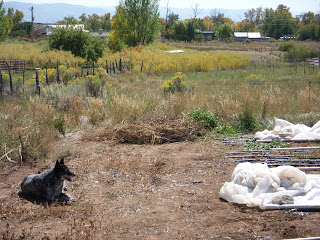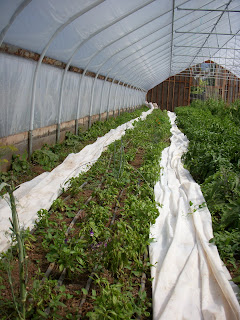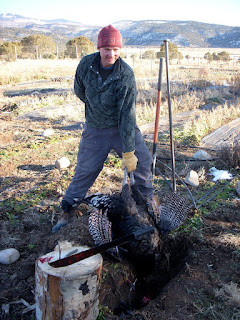The last weekend in September, Breigh, Noel, Jinelle, Jesse, and I set out on a road trip to New Mexico. After doing chores on Saturday morning, we packed the car and headed for our first stop, the Durango farmer’s market. Here we chatted with other farmers, compared prices, and bought apples. We had some lunch in Durango then hit the road for our next destination, Taos, New Mexico.
Driving in to Taos, we passed the “world headquarters” for Earthships, houses made entirely from recycled materials and built into the ground. It was a neighborhood consisting of over 100 Earthships. You couldn’t even see them all from the road and they spread over miles. We returned to this site on our way home, to have a look around the visitor’s center (which is an Earthship), but we found a seminar under way that prevented us from going inside. There were license plates from as far away as Ontario and Alberta in the parking lot.
The first farm we visited on Saturday was called Hondo Seco Farms, or “2 Blondes Farming” located just outside of Taos in a small town called Arroyo Seco at about 7,600 feet. We visited one part of this farming operation (it is somewhat spread out) and were welcomed by a charming blonde woman named Julie in overalls and knee-high rubber boots. “I’m doing irrigation today,” she explained. Irrigation was, in fact, one of the most interesting aspects of this farm for me.
At Buckhorn, we use only drip lines and hand watering as of now. At Hondo Seco, they use a system of small ditches to water their fields. They do this only once a week. Julie explained to us a peculiar ritual that they take part in order to obtain their water. They use the old acequias to water their fields and every six days they must visit the mayor and ask for their water to be turned on.
Hondo Seco also had a medium-sized hoop house, a mature and lovely orchard, a beehive, and a very nice looking chicken coop that housed a handful of young chickens.
 View of the Blondes' main field
View of the Blondes' main field Sweet chicken coop with young chickens
Sweet chicken coop with young chickens Jinelle and Noel inspecting the greenhouse
Jinelle and Noel inspecting the greenhouse Irrigation ditches - fascinating!
Irrigation ditches - fascinating!Saying goodbye and thank you to Julie at Hondo Seco, we hopped in the car to drive to our next destination, Beneficial Farms, in the hills outside of Sante Fe. Steve, who welcomed us, is farming at about 7,000 feet and living completely off the grid. He has owned the land since 1979 and began farming it 1994. The farm is part of a year-round CSA cooperative with several other farms in the area. It also produces 150 - 300 eggs a day from its large flock of chickens, which Steve sells wholesale. One greenhouse is home to tomatoes and peppers, and the roof can be opened during the summer.
The adobe/hay structures were one of the most impressive aspects of this farm. The intern/guest house has two sides made of hay, one of solid adobe, and the fourth of wooden frame. This structure is also the packing/processing center and there is a sunroom/green house attached on the south side. All of the living spaces, farming spaces, and animal spaces are completely off-grid, as I mentioned. Steve uses rainwater catchments, solar power, and wastewater recycling to accomplish this. Below is a photo of just two of the rainwater catchment tanks.
 Steve's fields and the adobe structures in the distance
Steve's fields and the adobe structures in the distance Two rainwater catchment tanks on the side of the intern/guest house
Two rainwater catchment tanks on the side of the intern/guest houseSteve left us with some words of wisdom on the value of obtaining ones own land and staying on it. He said that 30 years on the same patch of land has given him the ability to not only read his own land very well, but the ability to read unfamiliar land almost immediately as well. This skill allows him to time his crops well and to know what his soil needs. His thoughts were taken to heart among the five of us guests and I think we all ached a little inside just thinking about getting our hands on land of our own.
That night we camped out in Sante Fe National Forest, then headed back to Taos the next day for our final farm tour. We pulled into Morning Star Farms, back in Arroyo Seco, and Melinda, the farmer, greeted us warmly. Like Benefitial Farms, Morning Star practices Biodynamic farming. She has been farming for 12+ years and has had her CSA running for about 10. This year the CSA has about 54 full shares, all of which is produced on about 2 acres, much like ours, and she doesn't use a tractor either. She has two green houses full of tomatoes, basil, and many other warm season veggies. She also grows corn, which was impressive to us, given the size of our stalks this year. Her crops were grown very close together, which was some advice we learned from Steve the day before, in order to maximize water efficiency. As the soil gets better at Buckhorn, we should be able to start doing the same. Morning Star also attends the Arroyo Seco farmer’s market and also sells to local restaurants.
 Noel regards the corn with wonder
Noel regards the corn with wonder Morning Star's adorable farm dog, whose name I never caught
Morning Star's adorable farm dog, whose name I never caught There were at least two more rows of basil just like this. Pesto anyone?
There were at least two more rows of basil just like this. Pesto anyone?We said goodbye to Melinda and prepared for the long drive home. It was an excellent, educational, and beautiful trip.
--






























